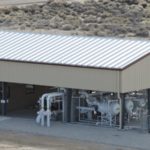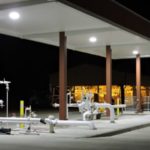- Company: Nova Group, Inc.
- Industry: Industrial
- Location: Edwards AFB, California
- Expected Completion Date: 4/1/16
This project included the demolition of the existing Bulk Fuel Storage Farm and replacement with a new fuel storage facility at the main base flight line providing closer fueling proximity to the aircraft. The new Bulk Fuel Storage System, which supplies jet fuel for the Air Force Test Center's aircraft, replaces the outdated system built in the 1950s that has functioned for nearly double its 30 year life expectancy. After over 60 years of service, the original system operated only with a waiver permitting operation at a max of 33 percent capacity, creating the potential to impact the mission by delaying fuel delivery to vital test aircraft. The old system required 30 minutes to fill two tank trucks. With the new system installed by Nova, those trucks can be filled in just 11 minutes improving fuel transfer at Edwards by 300 percent.
This fuel storage project includes construction of fuel transfer lines, aboveground fuel storage tanks, a pumphouse building, fuel operations building, emergency generator and truck loading and offloading capabilities. Significant scope features of the project included:
- Site preparation of 14 acres including 26,500 cubic yards of mass excavation and 15,000 cubic yards of mass fill to create the footprint for the main fuel storage and building locations
- Installation of 11,000 linear feet of 8” fuel pipeline with special environmental precautions for endangered species
- Erection of two 15,000-barrel aboveground fuel storage tanks in high-wind climate conditions
- Placement of 69,700 square feet (1100 cubic yards) of sloped berm concrete tank containment
- Construction of Two Fuel Truck Fillstands and Fuel Truck Offload stations including concrete paving and metal canopies
- Installation of a 30,000-gallon Chillstand Fuel Tank with containment constructed on the active airfield during on-going military operations
- Complete construction of pre-engineered metal Pumphouse Building (2,700 square feet) including all specialty fueling equipment and sophisticated control systems
- CMU/brick Operations Building (2,250 square feet) with a geothermal HVAC system requiring a complete re-design including a field of eight water loop wells bored 325 feet deep
- Area utility installation including medium voltage electrical, water and sewer
- Site improvements including parking, access roads, fencing, and signage
- Demolition of old fuel storage system upon successful completion of the new one
What impact does this project have on America?
Edwards Air Force Base, serving over 10,000 military, federal civilian and contract personnel, is home of the 412th Test Wing, responsible for all flight and ground testing of aircraft, weapons systems, software and components. Every single aircraft to enter the Air Force's inventory has been put through its paces at Edwards. Also home to NASA's Dryden Research Center, Edwards AFB serves as host to considerable test activities conducted by America's aerospace industry. Due to its location in the Mojave Desert, this 481-square mile installation features highly desirable climate conditions for these programs and in particular, includes two large dry lakes that serve as both emergency and scheduled landing sites for many aerospace projects. Arguably, more major milestones in flight have occurred at this base than anywhere else in the world.
This new fuel system restored optimal functionality to fueling operations at this critical Air Force testing facility which supports America’s overall on-going military operations.
What interesting obstacles or unusual circumstances did you overcome to complete the project?
Site & Local Climate Challenges: Unfortunately, the very conditions that make this base an optimal flight test and landing location do not translate into optimal construction conditions for a project involving heavy excavations, lengthy open trench requirements, and large steel tank erection. Nova regularly experienced high winds with gusts that exceeded 50 mph. The windy conditions in conjunction with the dry desert environment created an expansive 20 acre jobsite that required constant watering to comply with dust control requirements, particularly necessary for work adjacent to an active military airfield. With average high temperatures nearing 100 degrees in the summer months, Nova opted to perform concrete placement as early as 3 AM to beat the heat and the winds.
Endangered Species: Edwards AFB is home to the desert tortoise, a federally listed threatened species. The project required inspections three times per day of any open trench and creation of a sloped berm alongside the open excavation to deter tortoise entry. With an 11,000 lf transfer pipeline, Nova had approximately 2,000 lf of open trench on any given day with various stages of pipe installation. This desert tortoise protection created extra effort not normally required on a standard fuel pipe trench installation.
Value Engineering/Design Challenges: The Operations Building on this project required a geothermal HVAC system utilizing water-loop and ground-loop heat pump systems. In 35 years of 50+ fuel system installations with nearly identical building and system requirements, Nova had never encountered this unique system application on a fuels operation building. During the planning stages, Nova discovered that the specified design utilized standard components in what was considered a non-standard application, resulting in a system that manufacturers would not guarantee. The unique design considerations for the Operations Building including masonry mass walls for the exterior, an insulated roof deck with suspended acoustic ceilings, and a laboratory fume hood with high airflow requirements, presented obstacles that standard thermal design software did not easily address. Nova consulted a third-party HVAC designer, the Edwards AFB Civil Engineering HVAC maintenance department, several potential subcontractors, and the USACE local office to ultimately come up with recommendations for a workable system that could be warrantied. The partnering attitude of the Nova project staff, USACE Resident Office and base engineering personnel fostered an environment that created a successful solution to an incredibly challenging design issue that had potential to cripple completion of the project and prevent successful delivery of the much needed fueling upgrade. In a letter of appreciation to Nova, the Edwards Base Engineer stated “I am impressed with your partnering methodology which put my engineers’ nerves at ease. We thank you for the design and construction of the Geo-Thermal unit as this effort helped Edwards AFB maximize energy efficiency and help meet strict mandates on renewable energy.”
Post-Award Specialty Construction Challenge: The re-design of the Operations Building heating and cooling system required the installation a field of eight (8) water loop wells bored down 325 feet. Since this design was not originally included, the existing site conditions at that boring depth were not known. Site investigation revealed solid granite in this area creating a significantly more challenging installation. Further complicating this situation were the drought conditions facing California during the construction of this project which was keeping most drilling companies busy. Nova had difficulty finding a qualified drilling subcontractor willing and available to perform this difficult additional work in what is considered to be a fairly remote location.
Design Challenges: Although fully designed, the project required over 100 requests for design clarifications to the owner. Nova’s extensive government fuel system expertise enabled the project team to identify these items in the planning stages and in the true spirit of partnering, worked through them together preventing any impacts to the project for any of the vested parties. Specifically, Nova delivered the alternate geothermal HVAC system for the Operations Building to meet the renewable energy requirements at the facility, a key component to this project that could have crippled final completion. Nova’s proactive approach to clarifications included cost effective solutions that enabled the USACE to stay within project funding limits even with differing site conditions and design changes.
Ultimately, Nova delivered a fully operational bulk fuels system 8 months ahead of the required schedule. This early system hand-off enabled the Air Force to use the much needed system while Nova completed the demolition work and final incorporation of the complicated HVAC system re-design in the Operations Building. Final project turnover occurred two months ahead of the required completion. Nova delivered a quality project while maintaining a flawless safety record, and completed the project under budget, significant achievements when considering the quantity of clarifications, scope changes, adverse desert weather conditions, unforeseen site conditions and highly technical work requirements of the contract.
What dangers and risks did you encounter, and describe any extraordinary methods used to keep workers safe?
This project required working in extreme temperatures and high winds while surrounded by critical Air Force test flight operations. Nova’s safety record on this project was flawless – no lost time accidents or damage to Government assets by any Nova employee or subcontractor throughout the entire project. In particular, the construction of the fuel tanks became an issue because of the high winds. Nova's safety team initiated several innovative procedures to deal with the wind yielding success in maintaining both safety and the project schedule. Nova also performed high heat exposure work in the early morning to avoid maximum afternoon daily temperatures. Nova recognized the SSHO at Edwards AFB with “Safety Employee of the Year” award in 2014 for his passion for safety and overall involvement in keeping everyone safe onsite. The USACE also performed independent safety audits resulting in positive reports reflecting Nova’s full compliance and diligence in enforcing all Site Safety Plans.
How did you leverage new technologies to work faster and reduce waste?
LEED & Materials Innovation: Based on the primarily non-building work required, this military fuel storage facility did not qualify for a LEED certification, however, several environmentally-friendly practices, systems and methods were employed to minimize impacts both short and long-term on the environment. Although not eligible for a certification, Nova’s staff maintained the LEED documentation required to achieve points. This project had a detailed Waste Management Plan including significant efforts for waste minimization, diversion and recycling of construction materials. In total, over 5800 tons of materials were diverted from landfills:
• 3,704 tons of demolished concrete were turned into rip-rap for reuse on-site.• 1,800 tons of recycled fill were used for new road construction.
• 314 tons of metal were recycled from the demolition of the old bulk storage area.
• 5 tons of miscellaneous demolition metal were recycled over the course of the project
• 15 tons of miscellaneous recycling (wood, paper, and plastics)
The following approaches to achieving energy efficiency through materials innovation were incorporated:
• The sweeping overhangs, insulated roof deck, and mass wall shell were coupled with ground source geothermal heat pump systems, outside air intakes and stale air exhaust systems provide the occupants with continuously comfortable and fresh indoor air with a low carbon approach.• Active and passive sensors work with various building management systems to control the building’s high-efficiency lighting systems to further increase efficiency.
• Low flow fixtures were used to conserve water usage in a drought-prone area.
• Point of use and near point of use instantaneous water heaters substantially save on energy costs and further the water conservation efforts.
This building’s HVAC system is a prime example of what can be achieved through government/contractor collaboration to arrive at a pilot project that demonstrates the economic feasibility of implementing green-building practices to heat and cool a building in a harsh desert application.









